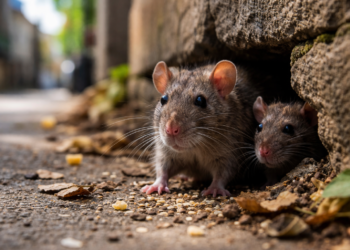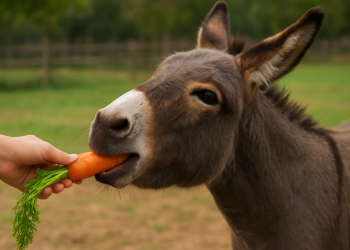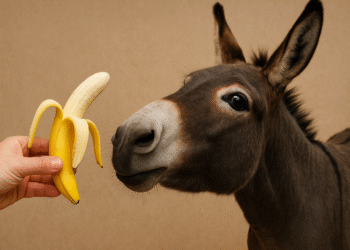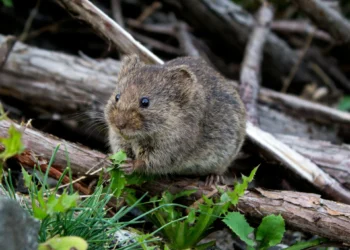Leopard geckos are fascinating creatures to keep as pets. They are low-maintenance and easy to care for, making them a popular choice among reptile enthusiasts. However, one question that often arises is whether leopard geckos can eat baby frogs. In this article, we will explore this topic in detail and provide you with the information you need to make an informed decision.
Leopard geckos are carnivorous and require a diet that is high in protein. They are known to eat a variety of insects, including crickets, mealworms, and waxworms. However, some owners may wonder if it is safe to feed their leopard geckos baby frogs as a source of protein. While frogs may seem like a natural food source for leopard geckos, it is important to consider the potential risks and drawbacks before introducing them into their diet.
Leopard Gecko Dietary Basics

As responsible pet owners, it’s important to understand the dietary needs of our leopard geckos. In this section, we’ll cover the natural diet of leopard geckos and their nutritional needs.
Natural Diet
Leopard geckos are insectivores, which means their natural diet consists of insects such as crickets, mealworms, and waxworms. In the wild, they may also eat small lizards, spiders, and other small invertebrates.
It’s important to note that leopard geckos do not eat fruits, vegetables, or any plant matter. Their digestive system is not designed to process these types of foods, and feeding them to your gecko can lead to health problems.
Nutritional Needs
Leopard geckos require a balanced diet that provides them with the nutrients they need to thrive. In addition to a variety of insects, they also need calcium and vitamin D3 to maintain healthy bones.
To ensure that your leopard gecko is getting the nutrients they need, it’s important to feed them a variety of insects and provide them with a calcium supplement. You can also provide them with a UVB light to help them produce vitamin D3 naturally.
While leopard geckos may occasionally eat small frogs in the wild, it’s not recommended to feed them to your gecko as they may contain harmful toxins. Stick to a balanced diet of insects and supplements to keep your leopard gecko healthy and happy.
Feeding Leopard Geckos Live Prey

Leopard geckos are carnivorous reptiles that require live prey to meet their nutritional needs. Feeding them live prey is an essential part of their diet, and it is important to choose the right type of prey to keep them healthy.
Safe Prey Choices
Leopard geckos can safely eat a variety of live prey, including crickets, mealworms, and waxworms. These insects are readily available and provide a good source of protein for your gecko. It is important to ensure that the insects are appropriately sized for your gecko, as larger insects can cause digestive problems.
Risks of Feeding Baby Frogs
While it may be tempting to feed your leopard gecko baby frogs, it is not recommended. There are several risks associated with feeding your gecko baby frogs, including potential health problems and the risk of injury to your gecko.
Firstly, baby frogs can carry parasites and diseases that can be harmful to your gecko. Additionally, baby frogs are small and can be difficult for your gecko to digest, which can cause digestive problems and even death.
Secondly, baby frogs can be aggressive and may bite or injure your gecko. This can cause stress and injury to your gecko, leading to long-term health problems.
In conclusion, while leopard geckos require live prey to meet their nutritional needs, it is important to choose safe prey choices. Avoid feeding your gecko baby frogs due to the risks associated with this type of prey. Stick to safe options like crickets, mealworms, and waxworms to keep your gecko healthy and happy.
Understanding Amphibians as Prey

When considering feeding leopard geckos, it is important to understand the potential risks and benefits of different prey items. In this section, we will discuss some important considerations when it comes to feeding amphibians to leopard geckos.
Potential Toxins in Frogs
Frogs are known to secrete toxins as a defense mechanism against predators. While not all frogs are toxic, it is important to research the specific species of frog before feeding it to a leopard gecko. Some common species of pet frogs, such as the African Clawed Frog, can be toxic to leopard geckos and should be avoided as prey.
Size and Digestibility Concerns
Another consideration when feeding leopard geckos amphibians is the size and digestibility of the prey item. Baby frogs may be too small to provide adequate nutrition for a growing leopard gecko, while larger frogs may be difficult for a leopard gecko to digest. It is important to choose appropriately sized prey items that are easy for the gecko to consume and digest.
In summary, while amphibians can be a nutritious and varied addition to a leopard gecko’s diet, it is important to carefully consider the potential risks and benefits of feeding them as prey. Researching the specific species of frog and choosing appropriately sized prey items can help ensure the health and well-being of your leopard gecko.
Alternative Food Options for Leopard Geckos
Leopard geckos are known to be carnivorous and require a diet rich in protein. While they primarily feed on insects, some leopard gecko owners might want to explore alternative food options for their pets. In this section, we will discuss two alternative food options for leopard geckos: commercially available insects and supplements and vitamins.
Commercially Available Insects
Leopard geckos can be fed a variety of commercially available insects such as crickets, mealworms, dubia roaches, and waxworms. These insects are readily available in most pet stores and online retailers. It is important to note that not all insects are created equal when it comes to nutrition. For example, crickets have a higher protein content compared to mealworms, but mealworms have a higher fat content. It is recommended to offer a variety of insects to ensure a balanced diet.
Supplements and Vitamins
In addition to feeding commercially available insects, it is important to supplement leopard gecko diets with vitamins and minerals. Leopard geckos require calcium and vitamin D3 for bone health. Calcium can be offered in the form of a powder that is dusted onto the insects before feeding. Vitamin D3 can be obtained through exposure to UVB lighting or through supplements. It is important to note that over-supplementation of vitamins and minerals can be harmful to leopard geckos, so it is recommended to follow dosage instructions carefully.
Overall, while leopard geckos primarily feed on insects, there are alternative food options available. It is important to ensure that any alternative food options are nutritionally balanced and do not contain harmful substances.
Feeding Practices and Frequency
Feeding Schedule
When it comes to feeding leopard geckos, it is important to establish a consistent feeding schedule. We recommend feeding baby leopard geckos every day, while adult leopard geckos can be fed every other day. It is important to note that leopard geckos are nocturnal animals and should be fed during the evening or at night.
Quantity and Portion Control
It is important to provide the appropriate amount of food for your leopard gecko. Overfeeding can lead to obesity, while underfeeding can lead to malnutrition. We recommend feeding baby leopard geckos small portions of food, such as small crickets or mealworms. Adult leopard geckos can be fed larger portions, but it is important to monitor their weight and adjust their portions accordingly.
When feeding baby frogs to leopard geckos, it is important to ensure that the frogs are small enough for them to consume. It is also important to note that leopard geckos should not be fed only one type of food, as this can lead to nutritional deficiencies. We recommend providing a varied diet that includes insects such as crickets, mealworms, and waxworms, as well as occasional treats such as baby frogs.
In conclusion, establishing a consistent feeding schedule and providing appropriate portion sizes are key to maintaining the health of your leopard gecko. When introducing new foods to their diet, it is important to do so gradually and monitor their reactions. As always, consult with a veterinarian if you have any concerns about your leopard gecko’s diet.
Signs of Nutritional Deficiencies or Overfeeding
As responsible pet owners, we want to ensure that our leopard geckos are receiving the proper nutrition they need to maintain good health. However, feeding them too much or not providing the right nutrients can lead to nutritional deficiencies or overfeeding. Here are some signs to look out for:
Nutritional Deficiencies
- Weight loss: If your leopard gecko is losing weight despite eating regularly, it may be a sign that they are not getting enough nutrients.
- Lethargy: A lack of energy or enthusiasm could be a sign of a nutritional deficiency.
- Bone deformities: Leopard geckos require calcium and vitamin D3 to maintain healthy bones. Without these nutrients, they may develop deformities or fractures.
- Stunted growth: Insufficient nutrition can lead to stunted growth, which can affect the overall health of your leopard gecko.
Overfeeding
- Obesity: Overfeeding your leopard gecko can lead to obesity, which can cause health problems such as fatty liver disease and decreased lifespan.
- Diarrhea: Feeding your leopard gecko too much can cause diarrhea, which can lead to dehydration and other health issues.
- Regurgitation: Overfeeding can also cause your leopard gecko to regurgitate, which can be harmful to their digestive system.
- Lack of appetite: If your leopard gecko is not showing interest in food, it may be a sign that they are being overfed.
In conclusion, it is important to monitor your leopard gecko’s diet and ensure that they are receiving the proper nutrition without overfeeding them. If you notice any signs of nutritional deficiencies or overfeeding, consult with a veterinarian to determine the best course of action.
Health Considerations and Veterinary Care

When it comes to feeding leopard geckos baby frogs, it’s important to consider their health and veterinary care. While leopard geckos are known for their hardiness and ability to adapt to a variety of diets, it’s still important to ensure that they are receiving the proper nutrition and care.
One potential health concern when feeding leopard geckos baby frogs is the risk of parasites. Frogs can carry a variety of parasites, including nematodes and protozoans, which can be harmful to leopard geckos. It’s important to ensure that any frogs you feed to your leopard gecko are from a reputable source and have been properly screened for parasites.
Another health consideration is the risk of injury. Leopard geckos may become injured while trying to catch and consume live prey, including baby frogs. It’s important to closely monitor your leopard gecko during feeding to ensure that they are not at risk of injury.
In terms of veterinary care, it’s important to schedule regular check-ups with a reptile veterinarian to ensure that your leopard gecko is in good health. Your veterinarian can also provide guidance on feeding and nutrition, as well as any potential health concerns that may arise.
Overall, while leopard geckos can eat baby frogs, it’s important to consider their health and veterinary care before incorporating this food into their diet. By ensuring that your leopard gecko is receiving the proper nutrition and care, you can help to ensure their long-term health and well-being.
Frequently Asked Questions
Is it safe for leopard geckos to consume small amphibians?
Leopard geckos are known to consume small amphibians in the wild, but it is not recommended to feed them baby frogs or any other small amphibians in captivity. This is because the amphibians may carry parasites or diseases that can harm the leopard geckos. It is best to stick to a diet of insects and commercially available gecko food.
Which amphibians, if any, can cohabit safely with leopard geckos?
It is not recommended to house leopard geckos with any species of amphibians. Leopard geckos are solitary animals and prefer to live alone. Additionally, the different environmental requirements of amphibians and leopard geckos can make cohabitation difficult.
Are there any risks associated with housing leopard geckos and frogs together?
Housing leopard geckos and frogs together can be risky. Leopard geckos may see the frogs as prey and try to eat them, which can lead to injury or death for the frogs. Additionally, the different temperature and humidity requirements of the two species can make it challenging to provide suitable living conditions for both.
What are the dietary preferences of leopard geckos regarding other small reptiles and amphibians?
Leopard geckos are primarily insectivores and do not typically consume other small reptiles or amphibians in the wild. In captivity, it is best to stick to a diet of insects and commercially available gecko food.
Can different species of geckos and frogs coexist in the same habitat?
Different species of geckos and frogs should not be housed together in the same habitat. Each species has unique environmental requirements, and cohabitation can lead to stress, aggression, and the spread of diseases.
What should be considered before introducing a leopard gecko to an enclosure with frogs?
Before introducing a leopard gecko to an enclosure with frogs, it is important to consider the temperature and humidity requirements of both species. Additionally, it is important to ensure that the enclosure is large enough to accommodate both species and that there is plenty of hiding places and basking spots for each animal. However, it is not recommended to house leopard geckos and frogs together.











